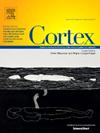Linking spatial metaphors to body size perception: Different roles of top-down associations and multisensory contributions when mapping auditory cues to finger length
IF 3.3
2区 心理学
Q1 BEHAVIORAL SCIENCES
引用次数: 0
Abstract
Temporospatial and semantic multisensory aspects contribute to bodily and spatial perception. An informative paradigm to study this is the Auditory Pinocchio Illusion, in which participants perceive an elongation of their finger upon vertically pulling their finger and hearing a concurrent upward pitch glissando. This arguably relies on anchoring (i.e., associating) the ecologically unrelated upward pitch glissando to the finger and allows to separately assess the role of semantic and multisensory contributions. However, what is needed for this anchoring to occur is unknown. In a first Experiment, we manipulated top-down attention to the finger upon which either an ascending or descending sound would be produced. In a second experiment, we compared how different bottom-up multisensory cues (arising from actions performed on the finger) concurrent to the ascending or descending pitch affected finger length perception. Participants either pulled, touched or stretched their finger. Through a perceptual judgment task of finger landmark localization and questionnaire ratings, we measured participants' perceived finger length in both studies and separately assessed their sensory imagery skills. Our results show that attention alters finger length perception according to questionnaire ratings but not perceptual judgements, while concurrent multisensory signals similarly affect both measures. No relationship between these effects and participants’ sensory imagery was found. We suggest that while top-down associations between pitch and verticality are necessary and affect questionnaire ratings, they are not sufficient to affect perceptual judgements. Bottom-up somatosensory cues seem to be additionally needed to impact such judgements in this illusion.
空间隐喻与体型感知的关联:将听觉线索映射到手指长度时自上而下关联的不同角色和多感官贡献
时间空间和语义多感官方面有助于身体和空间感知。研究这一点的一个信息范例是听觉匹诺曹错觉,参与者在垂直拉动手指并同时听到向上音高的滑音时感知到手指的伸长。这可能依赖于锚定(即,关联)生态学上不相关的向上音高滑音到手指,并允许单独评估语义和多感官贡献的作用。然而,发生这种锚定需要什么是未知的。在第一个实验中,我们将自上而下的注意力集中在手指上,在手指上产生上升或下降的声音。在第二个实验中,我们比较了不同的自下而上的多感官线索(由手指上的动作产生)是如何同时影响升或降音高对手指长度感知的。参与者要么拉手指,触摸手指,要么伸展手指。通过手指地标定位的感知判断任务和问卷评分,我们测量了两项研究中参与者感知到的手指长度,并分别评估了他们的感觉图像技能。我们的研究结果表明,注意会根据问卷评分改变对手指长度的感知,但不会改变感知判断,而同时发生的多感官信号对两种测量都有类似的影响。这些影响与参与者的感觉意象之间没有关系。我们认为,虽然俯仰和垂直度之间自上而下的联系是必要的,并影响问卷评分,但它们不足以影响感知判断。在这种错觉中,影响这种判断似乎还需要自下而上的躯体感觉线索。
本文章由计算机程序翻译,如有差异,请以英文原文为准。
求助全文
约1分钟内获得全文
求助全文
来源期刊

Cortex
医学-行为科学
CiteScore
7.00
自引率
5.60%
发文量
250
审稿时长
74 days
期刊介绍:
CORTEX is an international journal devoted to the study of cognition and of the relationship between the nervous system and mental processes, particularly as these are reflected in the behaviour of patients with acquired brain lesions, normal volunteers, children with typical and atypical development, and in the activation of brain regions and systems as recorded by functional neuroimaging techniques. It was founded in 1964 by Ennio De Renzi.
 求助内容:
求助内容: 应助结果提醒方式:
应助结果提醒方式:


